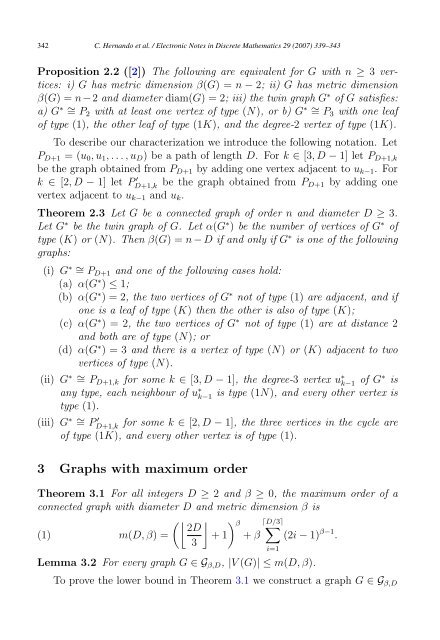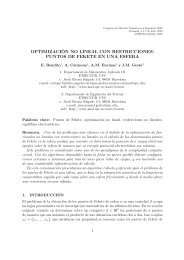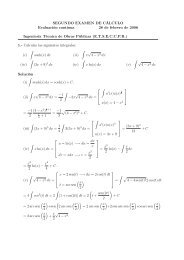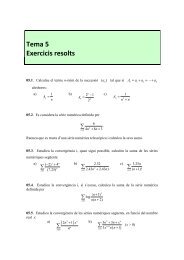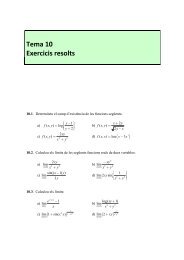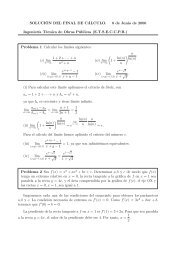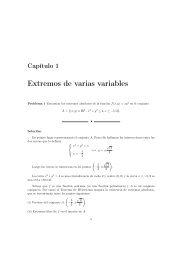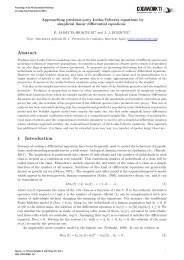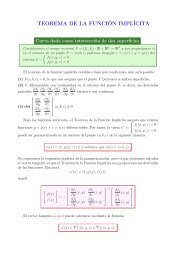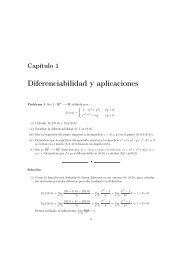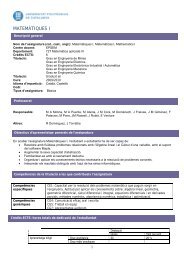Extremal Graph Theory for Metric Dimension and Diameter
Extremal Graph Theory for Metric Dimension and Diameter
Extremal Graph Theory for Metric Dimension and Diameter
Create successful ePaper yourself
Turn your PDF publications into a flip-book with our unique Google optimized e-Paper software.
342<br />
C. Hern<strong>and</strong>o et al. / Electronic Notes in Discrete Mathematics 29 (2007) 339–343<br />
Proposition 2.2 ([2]) The following are equivalent <strong>for</strong> G with n ≥ 3 vertices:<br />
i) G has metric dimension β(G) =n − 2; ii) G has metric dimension<br />
β(G) =n−2 <strong>and</strong> diameter diam(G) =2; iii) the twin graph G ∗ of G satisfies:<br />
a) G ∗ ∼ = P 2 with at least one vertex of type (N), orb)G ∗ ∼ = P 3 with one leaf<br />
of type (1), the other leaf of type (1K), <strong>and</strong> the degree-2 vertex of type (1K).<br />
To describe our characterization we introduce the following notation. Let<br />
P D+1 =(u 0 ,u 1 ,...,u D ) be a path of length D. For k ∈ [3,D− 1] let P D+1,k<br />
be the graph obtained from P D+1 by adding one vertex adjacent to u k−1 .For<br />
k ∈ [2,D − 1] let P ′ D+1,k be the graph obtained from P D+1 by adding one<br />
vertex adjacent to u k−1 <strong>and</strong> u k .<br />
Theorem 2.3 Let G be a connected graph of order n <strong>and</strong> diameter D ≥ 3.<br />
Let G ∗ be the twin graph of G. Let α(G ∗ ) be the number of vertices of G ∗ of<br />
type (K) or (N). Then β(G) =n − D if <strong>and</strong> only if G ∗ is one of the following<br />
graphs:<br />
(i) G ∗ ∼ = P D+1 <strong>and</strong> one of the following cases hold:<br />
(a) α(G ∗ ) ≤ 1;<br />
(b) α(G ∗ )=2, the two vertices of G ∗ not of type (1) are adjacent, <strong>and</strong> if<br />
one is a leaf of type (K) then the other is also of type (K);<br />
(c) α(G ∗ )=2, the two vertices of G ∗ not of type (1) are at distance 2<br />
<strong>and</strong> both are of type (N); or<br />
(d) α(G ∗ )=3<strong>and</strong> there is a vertex of type (N) or (K) adjacent to two<br />
vertices of type (N).<br />
(ii) G ∗ ∼ = P D+1,k <strong>for</strong> some k ∈ [3,D− 1], the degree-3 vertex u ∗ k−1 of G∗ is<br />
any type, each neighbour of u ∗ k−1 is type (1N), <strong>and</strong> every other vertex is<br />
type (1).<br />
(iii) G ∗ ∼ = P D+1,k ′ <strong>for</strong> some k ∈ [2,D− 1], the three vertices in the cycle are<br />
of type (1K), <strong>and</strong> every other vertex is of type (1).<br />
3 <strong>Graph</strong>s with maximum order<br />
Theorem 3.1 For all integers D ≥ 2 <strong>and</strong> β ≥ 0, the maximum order of a<br />
connected graph with diameter D <strong>and</strong> metric dimension β is<br />
(⌊ ⌋ β ⌈D/3⌉<br />
2D ∑<br />
(1)<br />
m(D, β) = +1)<br />
+ β (2i − 1) β−1 .<br />
3<br />
Lemma 3.2 For every graph G ∈G β,D , |V (G)| ≤m(D, β).<br />
To prove the lower bound in Theorem 3.1 we construct a graph G ∈G β,D<br />
i=1


